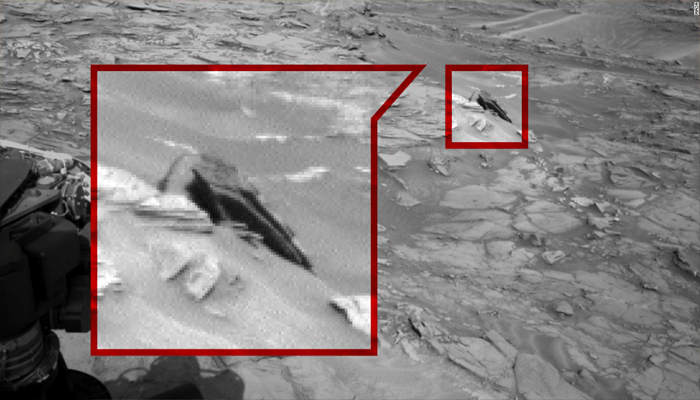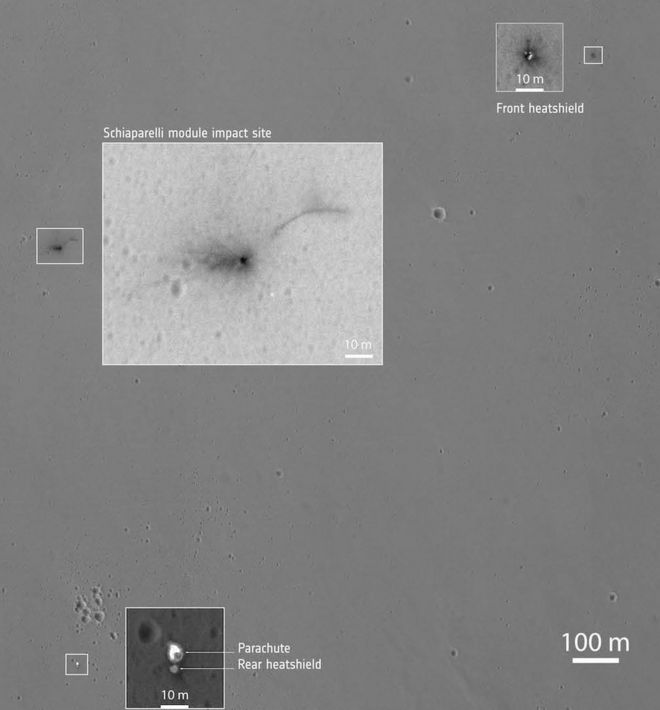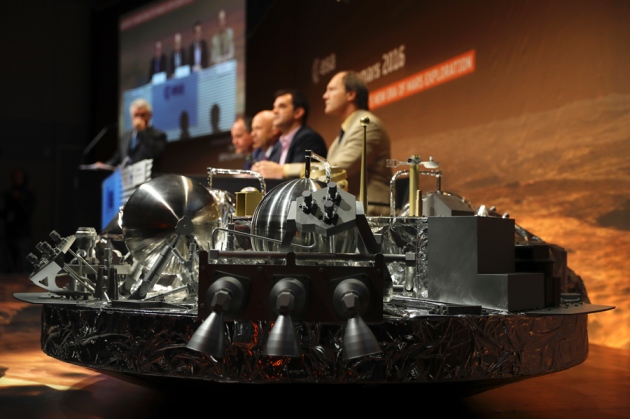The recent crash of the ExoMars Schiaparelli lander on Mars highlights how difficult it is to land there. So why is that? Why are landings on Mars so complex? And why do they fail so often? ESA is getting somewhat bad press for this. In my view, it validates the foresight of their approach to sending a test lander first. It also highlights the risk for manned missions to Mars and the planetary protection issues with humans on the Mars surface, which I’ve written about many times.
The basic problem is that Mars has double the gravitational field of the Moon. To fight against double the gravitational field requires a lot more than double the amount of fuel by the rocket equation (fuel has to carry more fuel), and the lunar module would have no chance at all of landing there.
Also, on the moon, you can orbit as close as you like to the surface, and the only problem is that you have to avoid hitting the mountains. You can adjust your orbit, wait for as many orbits as you like until ready, and if you have enough fuel, you can delay your landing while looking for a good place to land (as Apollo 11 did), abort back to a higher orbit if it fails, and with enough fuel, you can try again if needed and take your time about it.
On Mars, once you start the landing sequence and hit the atmosphere, you are committed. You are streaking through the atmosphere at kilometers per second. Everything after that has to work in a perfect sequence. The result is that a landing on Mars is far more complex than a landing on the Moon or indeed anywhere else in the inner solar system. It should be no surprise if spaceships to Mars crash.
Schiaperelli crash site on Mars. The cause of the crash is not yet known but one hypothesis is that it may be due to a computer glitch. ESA is getting a fair bit of bad press about this, but I think it just shows that it was a well-planned mission. This is the first time that anyone has sent a technology preview mission to Mars before their main mission. That it crashed shows the value of this approach and actually validates their decision.
Out of thirteen landers that have attempted to land on the surface of Mars itself, only seven have been successful, with one partial success Mars 3. There have been four crashes
Successes: Viking 1 and 2, Pathfinder, Phoenix, Spirit, Opportunity, and Curiosity.
Crashes: Mars 2, Mars Polar Lander, Deep Space 2 (same mission as MPL but separate landing) and Schiaperelli
Soft landing but no data or hardly any data, Beagle 2 and Mars 3
Even NASA has had crashes on Mars with its Mars Polar Lander and Deep Space 2 in 1999, which entered the Mars atmosphere independently and both crashed for different reasons. Since then, they have had a string of successes, with Phoenix, Spirit, Opportunity and Curiosity.
However, impressive though that is, you can get a string of four successes easily, even if the chance was only 50/50 of success each time. The chance of four successes in a row is then 1 in 16, or a 6.25% chance. This could mean that NASA is better at landing on Mars than ESA. But the statistical significance is not quite 2 sigma, not nearly good enough for scientific validation that they are statistically better than ESA and Russia. ESA did everything right, including using a radar to measure the distance to the ground.
The ESA has many deep space successes: Mars Express, Rosetta, the Philae Lander was a partial success and was attempting something never done before, Ulysses, the Huygens Titan probe, and Venus Express. NASA had its seven minutes of terror with Curiosity, which was not hyperbole, there was a real risk it would fail. Indeed, there is no guarantee that Curiosity 2020 will be a success. One hopes it will, of course.
Model of the Schiaparelli lander, photo: Kai Pfaffenbach/REUTERS
ESA has tested nearly all of the landing sequences with Shiaperelli, and they have returned 600 megabytes of telemetry about the landing sequence. The latest news in a paper published in Nature is that they suspect it may be a computer glitch that caused the crash. If so, this is good news, as a computer bug can be fixed much more easily than a hardware issue.
The total cost of ExoMars, including the test lander on Mars, is only $1.4 billion (though it may cost a few hundred million more) compared to Curiosity’s $2.5 billion. So the test lander on Mars should be compared to the testing NASA did on Earth for Curiosity as part of the total cost of that mission. ESA chose to do some of its testing on Mars itself.
Also, the lunar module can be any shape you like, as there is no atmosphere. The lunar module had a flimsy skin and was not in the least bit aerodynamic in its shape. A Mars lander has to have an aeroshell with a conventional-type landing. It can’t use its rockets until it discards the aeroshell. So the initial slowdown is more or less uncontrolled. You can tilt the aeroshell to give it some aerodynamic control, but not the control you have for a lunar landing.
All that makes it impossible to use a lunar module-type landing on Mars.
So then what about a parachute landing, such as they use on Earth? Well, you can use a parachute, and I think all the landers to date have used one. But the problem with a parachute, even a very large one, is that the atmosphere is so thin that you are still going hundreds of miles an hour when you hit the ground. That is just too much of a hard landing for most spacecraft to survive, though specially hardened penetrators can.
So, that’s two of the stages you have to have for conventional landings on Mars. First, the aeroshell and aerobraking. Then you need the parachute, because it would just take so much fuel to do all the slowing down using rockets.
So then you have to find a way to slow it down from those hundreds of miles an hour to a slow enough speed for a soft landing.
So that’s why you then have the retro propulsion stage for most landers on Mars. But you have to take care because if you do retro propulsion while the parachute is still attached, you will get the lander tangled up in the parachute. So you have to release the parachute first before you fire the rockets. So the moment of parachute release is very important to get that right. It seems that Schiaperelli, for some reason, released the parachute a bit too early, which was the start of its problems.
Even after that, you are still not quite home and dry. The problem is that, unlike a landing on the moon, you have no control over where exactly you land. Instead, you have a landing ellipse. This is the one for Schiaparelli, 100 km by 15 km
There is no chance at all of steering it during the landing, except possibly in the last few minutes; it is just totally dependent on whatever the atmospheric conditions are as you land. The Mars atmosphere is very thin, but it also varies hugely in density between day and night and there are lots of variations depending on altitude, temperature, etc so it is hard to predict exactly.
There’s also the uncertainty of the speed and position of the spacecraft as it enters the atmosphere; there’s always going to be some error there too.
So unlike a lunar landing, where Neil Armstrong could decide exactly where to set down the lunar rover and, if necessary, just fly a bit further to find a good spot, on Mars, you have to be able to land safely wherever you happen to be in that huge landing ellipse. Or you take the risk that if you hit a boulder, that’s the end of the mission.
Viking 1 landed not far from a boulder, which would have been the end of the mission if it had landed on it
They deal with that as best they can by choosing regions on Mars that are very flat; ideally, you want to have hundreds of square kilometers that are pretty much completely flat with no boulders or steep slopes. That’s why Curiosity had to drive for so long before it got to Mount Sharp. It wasn’t safe to land it any closer to Mount Sharp because it would then risk landing on a big boulder or on a steep slope.
Even so, the ground will be uneven and have small boulders. So you have to decide what to do about that. You could build in some smarts into the rocket to get it to fly sideways to avoid rocks, but so far nobody has tried to do that. They just let it land wherever it landed and built a robust system that could deal with irregularities like that.
So that’s the reason for the inflated airbags for Spirit, Opportunity, and Pathfinder, the skycrane of Curiosity, and the crushable base of Schiaparelli—to deal with the tricky last few meters lowering down onto rough terrain.
How Spirit and Opportunity landed on Mars.
Now there are two ideas for ways to simplify this process. The first is supersonic retropropulsion. That’s what Elon Musk plans to do for SpaceX.
Conceptually, it is about as simple as you can get. The rocket doesn’t have an aeroshell, parachute, or anything. It just decelerates.
Early artist’s impression of supersonic retro-propulsion
It slows down by coming in very, very close to the surface in the thicker atmosphere at huge speeds. Its rockets switch on when it is still traveling at supersonic speeds. It skims across the surface below the height of the higher mountains. Indeed if landing in the Valles Marineres, big rift valley, rift in the Martian highlands, it would need to skim down between the walls of the canyon.
All this time, the rocket is firing and it is also affected by the friction of the atmosphere. And then it comes to a vertical landing.
SpaceX has done this on Earth. Their barge landings of the first stage have to use supersonic retro-propulsion and what’s more, they can achieve a pinpoint landing as well, when it works. So it can certainly be done, but it is rather risky and tricky to do on Mars with the very thin atmosphere there and the atmosphere is far more variable in density than Earth’s atmosphere too.
The other way to do it is to use enormous parachutes. If the parachute is big enough, you can have a conventional landing, just like for Earth. Simply use aerosol, then parachute, and parachute down, and the parachute will slow you down enough so you get a soft landing.
The problem is deploying those parachutes and making sure they work. You can work it out with computer models, test tiny parachutes, etc. But at some point, you have to test it with real parachutes. The parachutes on Mars so far were tested by firing rockets in suborbital trajectories and then releasing parachutes, which required many tests.
Making even larger supersonic parachutes will require many expensive rocket tests. NASA is working on this with its Low-Density Supersonic Decelerator – Wikipedia
NASA “Flying Saucer” Supersonic Parachute Fails Test [Video]
I don’t think their plan is to use a parachute all the way down. Rather, it is to land larger masses, of up to 5 tons so would probably still need a complex landing system.
This is just a rough idea of how it works. For more on ways of landing on Mars with supersonic retro propulsion, large supersonic parachutes, etc, hear Robert Manning talk about it here Mon, 03/28/2016 – 14:00
Another approach is to send a penetrator. This has been tried in a small way with the Mars Polar Lander. It carried two miniature probes called Deep Space 2, which had their own separate aeroshells, entered the atmosphere separately from it, and hit the surface at 400 miles per hour, designed to do their final slowdown by penetrating the Mars surface.
Deep Space 2 failed; they don’t know for sure about the different hypotheses. Mars Polar Lander also failed. But this is interesting because it shows that we can also have several smaller spacecraft as part of a single mission to Mars—an idea that has never been tried before or since to date. Especially in the more distant future, we could send lots of miniature rovers on one mission.
Another possibility, for smaller missions at least, is to add balloons that don’t land on the surface at all. This gets rid of the last two stages of the complex procedure. Although the Mars atmosphere is very thin, balloons can still float in the atmosphere if they are light enough and have a small payload.
It is also possible to land a balloon in a planetary atmosphere, as we saw with the Venera probes for Venus. This would remove a lot of the complexity of the landing sequence and a Mars balloon could last for long periods of time and explore much of the surface of Mars. It could even come down to touch the surface with a trailing cable and do surface measurements.
Another idea is to send a plane that glides to the surface and does its science in that brief window before impact, the Mars Plane idea, and another idea is to send lots of miniature planes that can land through a controlled stall in the Mars atmosphere in near vertical orientation and take off again.
We could also send penetrators like Deep Space 2 along with any other mission. Indeed, Curiosity uses bars of metal, the “weight bar mass,” which it releases for trimming purposes, and one proposal by Gilbert Levin is to add life detection instruments on penetrators to those probes, which would not add anything to the weight of the mission or even change the design as those trimming bars are released anyway and impact the surface at high speed, which is ideal for a probe like that.
We could do all of these right now, years ago indeed, but NASA tends to be rather unadventurous, wanting to use ideas that it knows work or is pretty sure will work. It’s done many innovations, such as airbags and sky cranes, but the idea of adding miniature planes and balloons, more penetrators, hopping robots, and various other ideas seems a step too far at the moment for them.
NASA talks about these ideas and has studies done, but so far they have never gone beyond concept studies to an actual mission. I’m not sure why that is. But perhaps it is not surprising given the hundreds of millions of dollars price tag.
Perhaps as prices go down and other countries get involved, we may get missions like this.
We could also send interplanetary cubesats. Being very lightweight, they could be added as a secondary mission. Since that is done frequently on missions closer to home, I think it is only a matter of time before we start to get interplanetary cubesats included as a part of a Mars mission, communicating with Earth via orbiters around Mars. But AFAIK, there are no firm plans to include any of those in the near future upcoming missions by ESA, Russia, NASA or China (all of whom have plans to launch landers to Mars in 2020).
All this has major implications for planetary protection on Mars. Given how easy it is to crash on Mars, how can we possibly land humans there without a significant risk of a crash? A crash of a human-occupied mission on Mars would mean the end of all planetary protection on the planet.
I’d say that this means that our end objective for humans on Mars should be to have humans in orbit around Mars controlling rovers on the surface via telepresence, a very exciting mission in its own right. I think we shouldn’t look any further ahead but leave later decisions to be made once we understand Mars much better than we do now.




